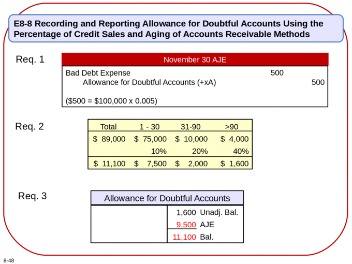What is Deferred Revenue? Definition + Examples
Content
This misleads your investors to believe that you’re growing when the reality is something different. It also enables them to guarantee future income, which can be helpful when forecasting revenue and making long-term strategic decisions. Every member has “reached” the advantage of having used the club for one month at the end of the first month of membership. As a result, the golf club has met its obligation to provide golf club benefits for a complete year in one month (1/12th).
It also helps you determine how much money you can expect to receive in the near future. Deferred revenue is very similar to deposits, and have sometimes been used interchangeably. You should go on adjusting the balance sheet and income statement as long as you are providing the service until you have nothing to owe, so the liability to the customer reaches zero.
Deferred Revenue
When a company receives advance payments for products or services to be performed in the future – think airfare or subscription services – the payments are a contract liability known as unearned or deferred revenue. Initially, companies record the prepayment amount as cash on the asset side, while the deferred revenue is accounted for as a liability. The deferred revenue in this case is considered a liability because it has not yet been earned; the product or service is still owed to the customer. When the product or service is eventually delivered, the amount of deferred revenue liability decreases and would become revenue on the company’s income statement. Deferred revenue, which is sometimes referred to as unearned revenue, is a term used to describe advance payments that businesses receive for services or products that haven’t yet been delivered.
Another common issue to be cognizant of is when the company acquired had the legal right to advance billed its customers but had not yet received the cash. Under GAAP, the acquiree would have recorded a receivable and deferred revenue, and the acquiree’s deferred revenue would be subject to the haircut. Deferred revenue, also known as unearned revenue, is a liability account that represents revenue received by a company in advance of earning it. This occurs when a company receives payment for goods or services that it hasn’t yet provided to the customer. Instead, the company recognizes the revenue over time as the goods or services are delivered or completed.
Examples of deferred revenue in accounting
It’s reported as a current liability if it’s expected to be earned within the next 12 months, or as a long-term liability if it’s expected to be earned after 12 months. Unless your Professional Services Firm strictly contracts on time and materials, you may need to account for deferred revenue. If you bill for a project, and have yet to fully complete the work, you have deferred revenue.
- If a customer pays for a one-year subscription upfront, the publisher would recognize the payment as unearned income.
- To understand deferred revenue in a little more depth, let’s look at an example.
- Accounting conservatism ensures the company is reporting the lowest possible profit.
- One such concept is deferred revenue, which can be a source of confusion for many.
- On the other hand, accrued expenses are expenses that a company records before they’ve made a payment.
- Learn financial statement modeling, DCF, M&A, LBO, Comps and Excel shortcuts.
- The club would credit SAR 120 in deferred revenue and debit SAR 120 in cash.
A similar term you might see under liabilities on a company’s balance sheet is accrued expenses. Whereas deferred revenue is money that a business has received but hasn’t provided the good or services for, accrued expenses are incurred when a business has received the good or service, but hasn’t paid the money. You record deferred revenue as a short term or current liability on the balance sheet. Current liabilities are expected to be repaid within one year unlike long term liabilities which are expected to last longer. Deferred revenue is a short term liability account because it’s kind of like a debt however, instead of it being money you owe, it’s goods and services owed to customers. Deferred revenue is a balance sheet liability that represents the amount of money owed to your company by your customers but which has not yet been invoiced.
Deferred Revenue: Definition & Examples
You have deferred revenue when you receive payment for goods services that you have not yet delivered or completed. This reduces your deferred revenue by $549 from $6,688 to $6,139 in January’s book closing statement. This method will continue as you recognize $549 every month from your deferred revenue balance until it reaches 0. The SaaS industry has seen an influx of deferred revenue in recent years due to the proliferation of the subscription business model and services requiring pre-payment.

The cash given to the unit is a liability because it represents an obligation the unit has to provide the good or service (and justify receiving the cash). At this stage, you will need to update the journal entry in the previous step by reducing the balance sheet liability and transferring the amount to the income statement. Assume a company received a payment of $5,000 in advance for services to be rendered over the next six months. Secondly, deferred revenue is often used as an indicator of future revenue growth potential. If a company has a large amount of deferred revenue on its balance sheet, it suggests that there are future sales that have already been secured, which can be an encouraging sign for investors.
Deferred revenue applies to companies that use accrual basis accounting. In a nutshell, deferred revenue is an accounting principle whereby revenues from a contract are recognized over time as the services performed. One way to potentially avoid some of the common pitfalls is to work with an accounting expert to review your liabilities and assets involving deferred revenue. Deferred revenue accounting is important https://kelleysbookkeeping.com/ for accurate reporting of assets and liabilities on a business’s balance sheet in accordance with the matching concept. Identify the services or goods for which you have already received payment but which you should still deliver till the end of the reporting period. As you identify these transactions, it’s high time for your accountants to calculate and record the amount of the deferred payment.

Recognized Revenue as of End Period is the rolling total of revenue recognized as of the end of that month. Let’s look at two examples to illustrate how deferred revenue for a subscription is impacted by invoicing differences. These articles and related content is the property of The Sage Group plc or its contractors or its licensors (“Sage”).
How to Avoid Common Mistakes in Acquisition Accounting
When a business receives payment for a service it has not yet provided, it generates deferred revenue. This typically occurs for service providers that hold off on doing the project until at least a portion of it has been paid for. Deferred revenue is earned when a business performs Deferred Revenue Definition its end of a contract after payment has been received. Assigning a specific adjustment account to track deferred revenue enables you to record unearned income as a liability and accurately recognize revenue as you fulfil the performance obligation(s) in your contract.

In all the scenarios stated above, the company must repay the customer for the prepayment. With Patriot’s small business accounting software, you can quickly add entries and view reports. We support thousands of small businesses with their financial needs to help set them up for success. Get a demo to learn more about how you can simplify your revenue recognition at scale.


